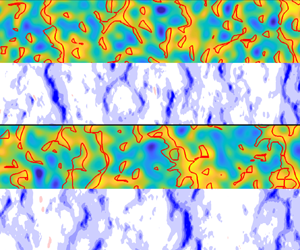Article contents
Direct numerical simulation-based characterization of pseudo-random roughness in minimal channels
Published online by Cambridge University Press: 04 May 2022
Abstract

Direct numerical simulations (DNS) are used to systematically investigate the applicability of the minimal-channel approach (Chung et al., J. Fluid Mech., vol. 773, 2015, pp. 418–431) for the characterization of roughness-induced drag on irregular rough surfaces. Roughness is generated mathematically using a random algorithm, in which the power spectrum (PS) and probability density function (p.d.f.) of the surface height can be prescribed. Twelve different combinations of PS and p.d.f. are examined, and both transitionally and fully rough regimes are investigated (roughness height varies in the range  $k^+ = 25$–100). It is demonstrated that both the roughness function (
$k^+ = 25$–100). It is demonstrated that both the roughness function ( ${\rm \Delta} U^+$) and the zero-plane displacement can be predicted with
${\rm \Delta} U^+$) and the zero-plane displacement can be predicted with  ${\pm }5\,\%$ accuracy using DNS in properly sized minimal channels. Notably, when reducing the domain size, the predictions remain accurate as long as 90 % of the roughness height variance is retained. Additionally, examining the results obtained from different random realizations of roughness shows that a fixed combination of p.d.f. and PS leads to a nearly unique
${\pm }5\,\%$ accuracy using DNS in properly sized minimal channels. Notably, when reducing the domain size, the predictions remain accurate as long as 90 % of the roughness height variance is retained. Additionally, examining the results obtained from different random realizations of roughness shows that a fixed combination of p.d.f. and PS leads to a nearly unique  ${\rm \Delta} U^+$ for deterministically different surface topographies. In addition to the global flow properties, the distribution of time-averaged surface force exerted by the roughness onto the fluid is calculated. It is shown that patterns of surface force distribution over irregular roughness can be well captured when the sheltering effect is taken into account. This is made possible by applying the sheltering model of Yang et al. (J. Fluid Mech., vol. 789, 2016, pp. 127–165) to each specific roughness topography. Furthermore, an analysis of the coherence function between the roughness height and the surface force distributions reveals that the coherence drops at larger streamwise wavelengths, which can be an indication that very large horizontal scales contribute less to the skin-friction drag.
${\rm \Delta} U^+$ for deterministically different surface topographies. In addition to the global flow properties, the distribution of time-averaged surface force exerted by the roughness onto the fluid is calculated. It is shown that patterns of surface force distribution over irregular roughness can be well captured when the sheltering effect is taken into account. This is made possible by applying the sheltering model of Yang et al. (J. Fluid Mech., vol. 789, 2016, pp. 127–165) to each specific roughness topography. Furthermore, an analysis of the coherence function between the roughness height and the surface force distributions reveals that the coherence drops at larger streamwise wavelengths, which can be an indication that very large horizontal scales contribute less to the skin-friction drag.
JFM classification
Information
- Type
- JFM Papers
- Information
- Copyright
- © The Author(s), 2022. Published by Cambridge University Press
References
REFERENCES
- 38
- Cited by


